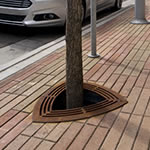Every great city has its iconic urban places that capture the city’s identity: Times Square in New York, the Champs d’Elysees in Paris, the Sunset Strip in Los Angeles. With the redevelopment of a 12-block section of 14th Street in Denver—now dubbed “Ambassador Street”—the Mile High City is rolling out a red carpet of its own, though, in this case, it’s green. With custom-manufactured landscape products that effectively widen the walkable area of the streetscape, studioINSITE’s design is helping reshape the city’s identity. Dennis Rubba takes us inside Denver’s newest and perhaps most subtle attraction and shows us the smart systems that make it work.
A Warm Welcome

Denver’s redesigned 14th Street features extra-wide sidewalks, ample bike lanes and street-side racks, light rail transit, and a clear wayfinding system for motorists. The project has helped attract $1.5 billion in new investment to the surrounding district.
“We wanted to make everyone feel special, like an actor or a celebrity when they come down the street,” Rubba says. But the new 14th Street, which has been certified Bronze by Greenroads, a LEED-like rating system for transportation corridors, is also an ambassador to the environment. “It’s raised the bar for sustainable streets in Denver … and improved the city’s sense of place,” Rubba says. The street is now as complete as can be: extra-wide sidewalks for pedestrians, ample bike lanes and street-side racks, light rail transit, and a clear wayfinding system for motorists give equal opportunity for each mode of transit. As a bonus, the revamped streetscape has helped attract $1.5 billion in new investment to the district.
Landscape Design Details
Not all of the design features that form the new streetscape are apparent to the casual observer. To maximize space for both street trees and people, Rubba specified IRONSMITH’s invisible Paver Grates. “Paver Grates allow you to extend walking surfaces over the root zone without compacting the soil,” says Bill Evans, a product design manager at the Palm Desert, California-based manufacturer. The 100-percent recycled, heavy-duty steel grates are an “invisible, suspended paving system,” he says. A perimeter concrete footing allows the grates to span the topsoil around street trees and supports the weight of the pavers several inches above the root zone. “We custom built these according the designers’ specifications,” Evans says of the unique cutouts in the grates where the tree trunks emerge—a design motif that Rubba repeats throughout the streestscape as a form of visual branding.
Growing an Urban Forest
Pollution, compacted soils, and seas of impervious paving make life tough for street trees everywhere, and Denver’s extreme climate doesn’t help. Previously, city regulations said street trees could not be planted closer together than 35 feet, but Rubba advocated for 20-foot spacing so the trees would be sure to provide shade even if they did not reach their full spreads. When it rains, the Paver Grates allow runoff to percolate right through the sidewalks, rather than rushing into the city’s storm drains. The system “allows the soil to breathe and water to permeate the root zone,” Rubba says. As a result, a lush forest is already emerging on 14th Street. And the extra pedestrian space provided by the Paver Grates means plenty of space for people to congregate in the shade as they meander down Denver’s new main street.

